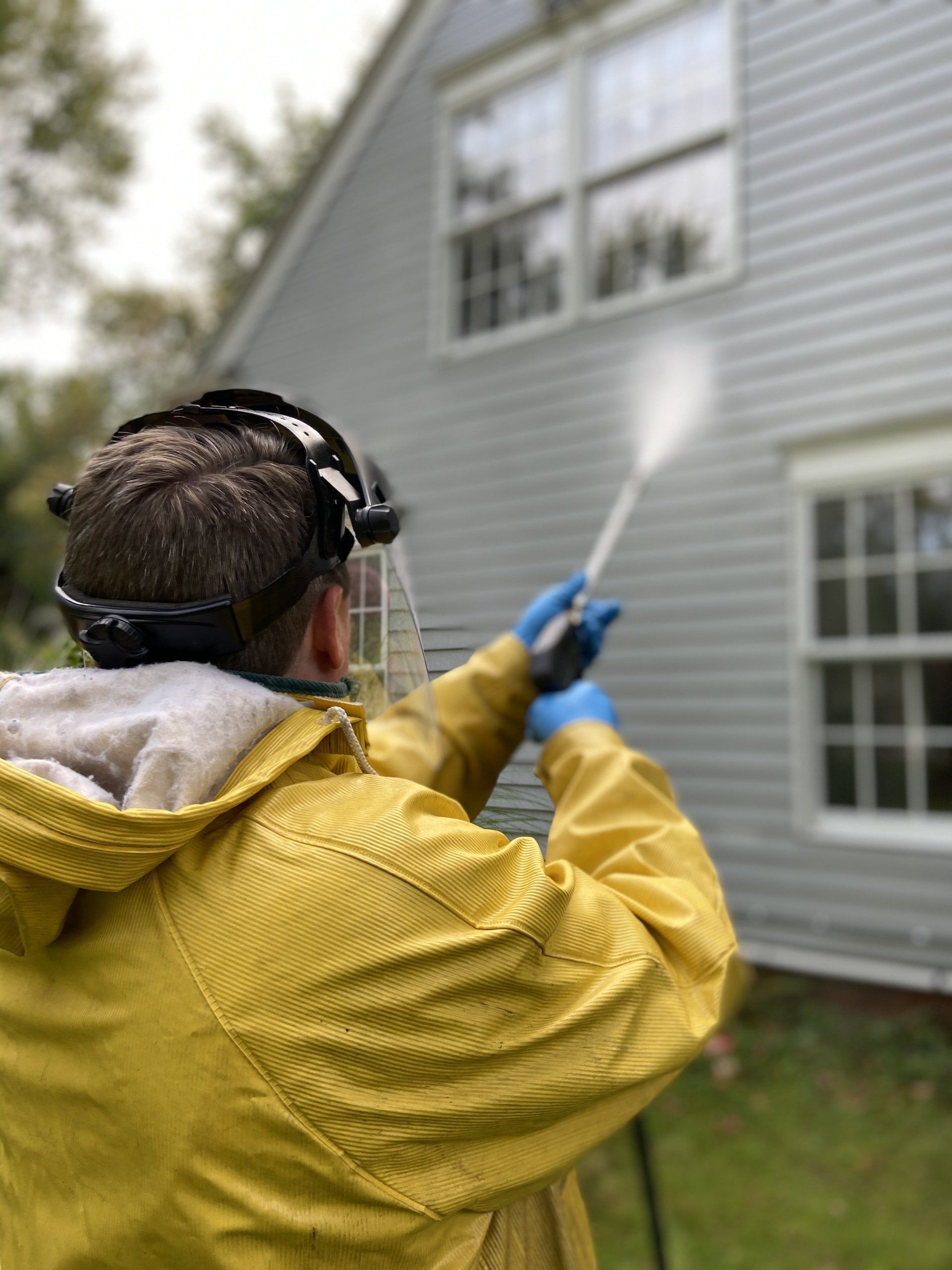Exploring Advanced Sandblasting Methods for Professional Results
Discover the art of achieving professional results through advanced sandblasting techniques in this comprehensive guide. With a focus on providing clear and straightforward information, we delve into the world of sandblasting, offering insights, tips, and examples to help you master this powerful method. From understanding the equipment needed to exploring various application techniques, this guide aims to empower you with the knowledge and confidence to achieve outstanding results in your sandblasting projects. Join us on this informative journey as we unlock the secrets to successful sandblasting for professional outcomes you can trust.
Understanding Sandblasting Fundamentals
Essential Tools for Sandblasting
Before diving into the various sandblasting methods, it's crucial to familiarize yourself with the essential tools required for the job. At the core of any sandblasting operation is the sandblaster itself, which comes in different sizes and types depending on the project's scale and complexity. You'll also need an air compressor to power the sandblaster, with a capacity suitable for your equipment's requirements.
Abrasives are at the heart of sandblasting; these materials are what actually strip paint, rust, or other coatings from surfaces. Common abrasives include sand, glass beads, and steel grit, each with specific properties and uses. Personal protective equipment (PPE) is non-negotiable – safety glasses, gloves, and a respirator are minimum requirements to protect against airborne particles. Lastly, for precision work, a sandblasting cabinet can be invaluable, containing the material being blasted and recycling the abrasive.
Understanding these tools is the first step in ensuring your sandblasting project starts on the right foot.
The Science Behind Sandblasting
The effectiveness of sandblasting lies in the science of high-speed particle collision. When abrasive particles are propelled at a surface, their impact energy strips away unwanted material like paint, rust, or grime. The size, shape, and hardness of the abrasive materials, combined with the velocity at which they are projected, determine the speed and efficiency of the cleaning or etching process.
The kinetic energy of the abrasive particles is a critical factor in sandblasting. This energy is what allows the particles to erode the surface material upon impact. The pressure at which abrasives are blasted and the angle of impact also play significant roles. An optimal angle allows for maximum impact energy transfer, enhancing the sandblasting process's effectiveness.
Understanding these scientific principles can help you choose the right equipment, abrasive media, and techniques for your specific sandblasting project, ensuring you can achieve the desired results efficiently and effectively.
Safety Precautions in Sandblasting
Safety should always be the top priority when conducting sandblasting operations. The high-velocity abrasives used in the process can pose serious risks if proper precautions are not taken. To start, operators should wear appropriate personal protective equipment (PPE) including a heavy-duty sandblasting suit, gloves, ear protection, and a helmet with a face shield to protect against flying particles.
Respiratory protection is equally important. The fine dust generated can be harmful if inhaled, so wearing a respirator specifically designed to filter out fine particulates is crucial. Additionally, ensuring a well-ventilated area is key to preventing the buildup of airborne particles.
Regular maintenance and inspection of equipment can prevent malfunctions that may lead to safety hazards. Also, be aware of your surroundings and make sure that no unauthorized persons enter the sandblasting area during operations. By adhering to these safety guidelines, you can minimize risks and protect yourself and others around you during sandblasting projects.
Single Stage Sandblasting Methods
Wet Sandblasting Technique
Wet sandblasting is a variation of the traditional sandblasting method that incorporates water into the process. This technique helps to reduce the amount of airborne dust, making it a safer and more environmentally friendly option. In wet sandblasting, water and abrasive materials are mixed and then propelled at high speed towards the target surface.
The addition of water to the abrasive mixture has several benefits. It increases the mass and energy of the particles, which can result in a cleaner, more efficient process. Additionally, the water aids in trapping the dust particles, which not only improves visibility during the operation but also minimizes the risk of inhaling harmful particulates.
However, one must consider the potential for water-induced damage or rusting on certain surfaces. Thus, it's important to know the material you are working with and whether it can withstand exposure to moisture during the sandblasting process.
Dry Sandblasting Method
Dry sandblasting is the most widespread form of sandblasting, which, as the name suggests, does not use water. This technique involves propelling dry abrasive materials, such as sand or glass beads, against a surface to clean or alter its texture. Dry sandblasting is highly effective for removing coatings, rust, and other surface imperfections.
One of the key advantages of the dry sandblasting method is its speed and efficiency. The lack of water means there is no need for drying time, allowing for immediate inspection and further treatment of the surface if necessary. Dry sandblasting is also versatile and can be used on a wide range of materials, including metal, stone, and wood.
However, this method does generate significant amounts of dust, making it essential to use proper ventilation and respiratory protection. Additionally, it's important to ensure that the work area is well-contained to prevent environmental contamination and health hazards associated with the spread of fine particles.
Bead Blasting and Its Effectiveness
Bead blasting is a form of sandblasting where fine glass beads are used as the blasting medium. This method is particularly effective for creating a smooth, uniform surface finish without causing damage to the substrate. Bead blasting is ideal for applications where surface integrity is crucial, such as in automotive restoration or the preparation of metal surfaces for painting.
The glass beads used in bead blasting are spherical, which allows them to hit the surface and rebound without etching or leaving a rough texture. This characteristic makes bead blasting an excellent choice for cleaning delicate parts or removing contamination from surfaces where maintaining the original precision is important.
Moreover, bead blasting is environmentally friendly since glass beads can be recycled multiple times before disposal. This process is also less abrasive compared to other methods, reducing the wear on blasting equipment and extending the life of the machinery.
Advanced Sandblasting Techniques
The Suction Blast Method
The suction blast method, also known as a siphon blast, is an advanced sandblasting technique that differs from the traditional pressure blast systems. In this method, a gun is used to create a vacuum that sucks the abrasive material from a container and then propels it out towards the target surface. This is achieved by the Venturi effect, where the high-speed airstream passing through the gun's nozzle decreases pressure and induces suction.
Suction blasting is particularly advantageous for small-scale operations or when precision is necessary. It allows for a greater degree of control over the abrasive flow, which can be crucial when working with delicate items or when detailed work is required. The suction method is also typically less expensive and simpler to operate than pressure systems, making it accessible for smaller shops or hobbyists. However, it's important to note that suction blasting may be less powerful than direct pressure blasting and could be less efficient for larger jobs or tougher coatings.
Direct Pressure Sandblasting
Direct pressure sandblasting is an advanced technique that relies on a pressurized tank to blast abrasive materials directly onto a surface. This method is known for its high efficiency and speed, making it suitable for large-scale projects or for removing particularly tough coatings. Unlike suction blasting, direct pressure sandblasting allows for a continuous flow of abrasive material, which results in a more consistent and faster cleaning action.
The pressure tank is filled with the abrasive, and when the system is activated, the material is forced out through a hose and nozzle at high velocity. This direct application of pressure increases the impact of the abrasive particles, which can significantly reduce blasting time and is effective even on very hard surfaces.
While direct pressure sandblasting is powerful, it also requires more sophisticated equipment and safety measures due to the high pressures involved. Operators must be well-trained to handle these systems, and appropriate protective gear is essential to ensure safety during the blasting process.
The Bristle Blasting Technique
The bristle blasting technique is a unique variant of traditional sandblasting that doesn't require separate abrasive media. Instead, this method utilizes a rotating brush-like tool with steel wire bristles designed to strike the surface being cleaned. As the bristles hit the surface, they retract and eject corrosion, mill scale, and other contaminants, while simultaneously creating a micro-indentation that exposes fresh material.
A significant advantage of bristle blasting over conventional methods is the elimination of airborne dust and the containment of waste material, making it a cleaner process. This technique is especially useful for maintenance and repair operations where it's crucial to minimize environmental impact and cleanup time.
Bristle blasting is also known for its ability to prepare metal surfaces to near-white or white metal appearance, which is an excellent foundation for coating adhesion. Effective on both ferrous and non-ferrous materials, the bristle blasting technique is an innovative solution for surface preparation that combines cleaning and profiling in one step.
Professional Sandblasting Results
Keys to Achieving Professional Finish
Achieving a professional finish in sandblasting is a combination of precision, technique, and the right equipment. The key to a high-quality outcome starts with proper surface preparation. This means thoroughly cleaning the surface and removing any contaminants that could interfere with the sandblasting process. Selecting the appropriate abrasive media is also critical, as different materials can yield different finishes.
Control of the sandblasting equipment is another essential factor. Operators should maintain a consistent distance and angle to the surface to avoid uneven patterns or damage. The pressure settings need to be adjusted to match the surface hardness and the desired finish, whether that’s a smooth polish or a specific texture.
Finally, regular maintenance of the sandblasting equipment ensures that it operates at peak efficiency, which contributes to a professional finish. This includes checking for worn nozzles or hoses and ensuring the abrasive media is free of contaminants. Attention to these details will help produce the desired professional result.
Correcting Common Sandblasting Mistakes
To ensure the best possible outcome in sandblasting, it's important to be aware of and correct common mistakes. One frequent error is using the wrong type of abrasive for the job. This can lead to inadequate cleaning or even damage to the substrate. Always match the abrasive to the surface and the task at hand.
Another common oversight is failing to maintain a consistent distance and angle when blasting. This inconsistency can cause uneven surface profiles or pitting. Practice and experience, along with careful monitoring during the process, can help prevent these issues.
Improper equipment settings can also lead to poor results. Too much pressure can erode the surface excessively, while too little pressure may not be effective. Regularly checking and calibrating your equipment can mitigate this problem.
Lastly, neglecting safety protocols can lead to accidents or health risks. Always ensure that all safety measures are strictly followed, including the use of appropriate personal protective equipment and dust extraction systems. Addressing these common mistakes will help achieve professional sandblasting results.
Techniques for Different Surface Types
Tailoring your sandblasting technique to the type of surface you're working with is crucial for achieving optimal results. Soft surfaces, such as wood or certain plastics, require a gentle touch with lower pressures and softer abrasives like walnut shells or corn cob media to avoid damage. For harder surfaces, such as metal or concrete, more aggressive abrasives like aluminum oxide can be used at higher pressures to effectively remove coatings or create the desired surface profile.
When dealing with intricate or detailed surfaces, precision is key. Using a smaller nozzle and a controlled hand can help focus the abrasive stream and protect delicate areas. For large, flat surfaces, using a broader nozzle and a sweeping motion can cover larger areas more efficiently while maintaining an even finish.
It's also essential to consider the condition of the surface. Surfaces with extensive corrosion or old paint might need pre-treatment or a stronger abrasive to achieve a clean surface ready for further processing or coating. Each surface type demands a specific approach, and understanding these nuances is the hallmark of a professional sandblasting service.
Comprehensive Guide To Maintain Sandblasting Equipment
Basic Equipment Maintenance Routine
Regular maintenance is vital for the longevity and performance of sandblasting equipment. A basic routine should include inspecting and cleaning the machine after each use. Remove any residual abrasives or debris from the blasting cabinet, hose, and nozzle, as these can cause clogs or uneven blasting patterns.
Check for wear and tear on all components, especially the nozzle and hose, which can wear down over time due to the abrasive nature of the materials they handle. Replacing these parts before they fail can prevent downtime and ensure consistent performance.
Lubricate moving parts as necessary to keep them operating smoothly. It's also important to check the air compressor and its filters. A well-functioning compressor is essential for maintaining the correct pressure levels, while clean filters prevent contaminants from entering the system and compromising the quality of the blast.
Implementing a regular maintenance schedule will not only prolong the life of your equipment but also ensure that it's always ready for optimal operation.
Troubleshooting Sandblasting Equipment Issues
When encountering issues with sandblasting equipment, knowing how to troubleshoot can save time and resources. If you notice a decrease in blasting power or inconsistent flow, start by checking the air compressor for proper pressure and flow. Air leaks in the system can also lead to a loss of power, so inspect hoses and couplings for any signs of damage or wear.
If the abrasive is not coming out evenly, the issue may be a clogged nozzle or a jam in the supply line. A thorough cleaning can often resolve this problem. Look for any abrasive material build-up or foreign objects that could be obstructing the passage.
For problems with the abrasive media itself, such as clumping, ensure that the material is dry and free-flowing. Humidity can cause certain abrasives to clump together, so storage conditions are crucial.
If all else fails, consulting the equipment's manual or reaching out to the manufacturer can provide specific guidance tailored to your machinery. Keeping a log of maintenance and issues can also help diagnose recurrent problems more efficiently.
Upgrades and Improvements for Greater Efficiency
Enhancing the efficiency of sandblasting equipment can lead to better performance and cost savings. Upgrading to a more powerful air compressor can provide a steadier and stronger stream of air, allowing for quicker and more consistent sandblasting. Additionally, investing in a higher-quality blast nozzle made from materials like tungsten carbide can offer a longer lifespan and better abrasion resistance.
Another improvement is the installation of a dust collection system. This not only helps to maintain a cleaner work environment but also improves visibility during the blasting process, allowing for more precise work. Automating certain parts of the sandblasting process can also be beneficial. For example, using a timed blasting cabinet can ensure consistent results and free up operators to work on other tasks.
Regularly upgrading hoses, valves, and fittings to more durable and efficient versions can prevent leaks and pressure drops. Keeping abreast of new technologies and materials in the sandblasting industry can provide opportunities to improve efficiency and achieve professional results more consistently.




